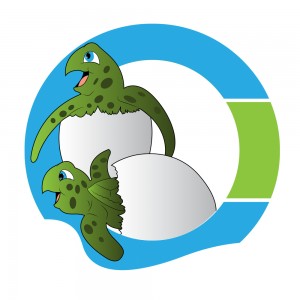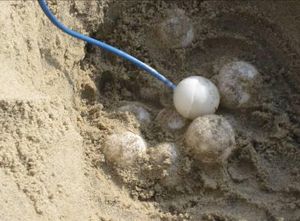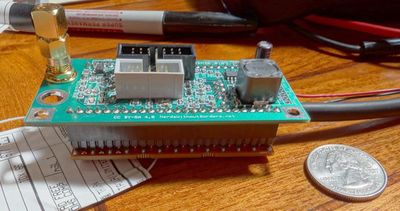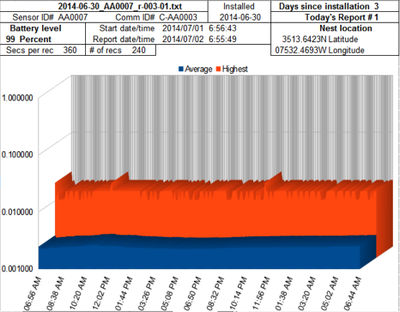Difference between revisions of "Turtle Sense"
| Line 5: | Line 5: | ||
==Background== | ==Background== | ||
[[File:Hawaii turtle 2.JPG|400px|right]] | [[File:Hawaii turtle 2.JPG|400px|right]] | ||
| − | Sea turtles have existed for 100 million years, but in the last century the impacts of man through accidental capture in fishing nets, habitat destruction, pollution, and plastics in the ocean, have significantly reduced populations by as much as 95%. Six of the seven species nest in the warmer beaches of the US, and all of these are protected by the Endangered Species Act of 1973. Although volunteer groups and park personnel can identify egg laying sites almost immediately, the hatching date (when they emerge on the beach) cannot be predicted—it will happen sometime in a six- week period beginning 50 days after the eggs are laid. All 100 to 150 of the sea turtle hatchlings in a nest appear simultaneously (usually at night) on that unpredictable date during that six-week period. The hatchlings “boil” out of the sand and begin a dash to the ocean, one of the most touching sights in nature. | + | Sea turtles have existed for 100 million years, but in the last century, the impacts of man through accidental capture in fishing nets, habitat destruction, pollution, and plastics in the ocean, have significantly reduced populations by as much as 95%. Six of the seven species nest in the warmer beaches of the US, and all of these are protected by the Endangered Species Act of 1973. Although volunteer groups and park personnel can identify egg-laying sites almost immediately, the hatching date (when they emerge on the beach) cannot be predicted—it will happen sometime in a six- week period beginning 50 days after the eggs are laid. All 100 to 150 of the sea turtle hatchlings in a nest appear simultaneously (usually at night) on that unpredictable date during that six-week period. The hatchlings “boil” out of the sand and begin a dash to the ocean, one of the most touching sights in nature. |
| − | Beginning at 50 days after the eggs are laid, the National Park Service (NPS) at the Cape Hatteras National Seashore fences off a lane from the nest to the ocean and forbids other access to that lane until either the hatchlings appear or the 100 days has elapsed. This long protection period creates conflicts with other uses for | + | Beginning at 50 days after the eggs are laid, the National Park Service (NPS) at the Cape Hatteras National Seashore fences off a lane from the nest to the ocean and forbids other access to that lane until either the hatchlings appear or the 100 days has elapsed. This long protection period creates conflicts with other uses for beach access, such as fishing and vehicular movement for recreation and safety. Conflicts are inevitable, often leading to lawsuits. |
== Project objective== | == Project objective== | ||
Revision as of 10:48, 2 October 2014
- Using high tech sensors and cell phone networks to protect sea turtle hatchlings
You can help support the project with a tax deductable donation (Click here).
Background
Sea turtles have existed for 100 million years, but in the last century, the impacts of man through accidental capture in fishing nets, habitat destruction, pollution, and plastics in the ocean, have significantly reduced populations by as much as 95%. Six of the seven species nest in the warmer beaches of the US, and all of these are protected by the Endangered Species Act of 1973. Although volunteer groups and park personnel can identify egg-laying sites almost immediately, the hatching date (when they emerge on the beach) cannot be predicted—it will happen sometime in a six- week period beginning 50 days after the eggs are laid. All 100 to 150 of the sea turtle hatchlings in a nest appear simultaneously (usually at night) on that unpredictable date during that six-week period. The hatchlings “boil” out of the sand and begin a dash to the ocean, one of the most touching sights in nature.
Beginning at 50 days after the eggs are laid, the National Park Service (NPS) at the Cape Hatteras National Seashore fences off a lane from the nest to the ocean and forbids other access to that lane until either the hatchlings appear or the 100 days has elapsed. This long protection period creates conflicts with other uses for beach access, such as fishing and vehicular movement for recreation and safety. Conflicts are inevitable, often leading to lawsuits.
Project objective

The goal of the project is to develop simple inexpensive technology for determining when a boil will occur with as much accuracy and reliability as possible. The current design employs a sensor that measures egg motion either as the embryos agitate in the egg or as the sea turtle hatchlings begin to pip out of the eggs or both. The results, perhaps including modeling, will hopefully be able to predict hatching dates (arrival on the beach) to a reliable one-to-three-day window, a significant improvement over the current six-week window. Developing a reliable technology for predicting hatching will allow the NPS to create a new protocol for protecting the nests, thus freeing up access to the beaches for a significantly longer time.
There are several possible beneficial side effects of the technology. Firstly, the technology can be used to help develop ecotourism around the hatching of sea turtles. Once people (especially young people) experience the hatching of these creatures, they may be much more likely to think positively about the welfare of sea turtles in the future. Secondly, if local people can develop an income around this ecotourism activity, they may be less averse to the obstructions to beach vehicles and foot traffic. Finally, the technology might be useful for scientists studying sea turtles and might be adaptable for the study of other egg-laying species.
All the designs and software code will be published on this website and will be available for use worldwide. All data created by the system will be made available to researchers worldwide.
History
The device began with an idea from Eric Kaplan, Founder of a company which develops Bluetooth wireless technology test equipment. Kaplan sold his company to his employees and founded the Hatteras Island Ocean Center (www.hioceancenter.org), a nonprofit, 501(c)(3) ecology education center on Hatteras Island in North Carolina. Kaplan saw the need for this technology and approached his childhood friend Tom Zimmerman, an IBM Research–Almaden (San Jose, CA) electrical engineer for assistance. Zimmerman designed the sensor package in 2013 as a public service commitment from IBM. Tom recruited his college buddy, Samuel Wantman a retired software designer, and they worked on developing the first phase of the design with support from IBM and from the National Park Service. Britta Muiznieks, a biologist with the NPS has been coordinating the Park's involvement. The first phase of the project was a very quick and inexpensive hack of cell phones with a simple custom circuit board to test the viability of the project. The devices were tried in a few nests in 2013, but unfortunately it was too late in the season to get any data from viable nests. Even so, there was enough learned to make everyone involved in the project believe that there was the potential to make the technology work.
Wantman took over management of the project in 2014, as Zimmerman had to return to other commitments at IBM. Additional volunteers were recruited, including David Hermeyer a retired electrical engineer and Charles Wade a retired IBM Research manager. Phase two of the project involves developing a more robust custom sensor embedded in a plastic sphere the same size and shape as a turtle egg, with industry standard technology for transmitting data over cell phone networks. Installation has begun on multiple sensors that the NPS is funding for field testing in 2014. The project inspired Samuel Wantman to start Nerdswithoutborders.net to help organize the project, recruit volunteers, and inspire other projects. All of the Turtle Sense project members, with the exception of the NPS employees, donate their time. The Hatteras Island Ocean Center is the sponsoring non-profit institution that administers receipt and disbursement of funds for materials and other expenses.
Phase One description
For Phase One, a motion and temperature sensor sealed in a ping-pong ball was placed in the sea turtle nest. It was connected to a hacked cell phone which was programmed with a very small low-powered microprocessor to send out text messages with the motion and temperature data. Turtle eggshells are thick and leathery, so the hatchlings need considerable effort to emerge from the egg. After leaving the egg, the hatchlings remain in the nest for two to four days before exiting as a group onto the beach. All the resulting motions should activate the accelerometer sensor and thus provide data to the phone network. Field tests done at Hatteras in 2013 were positive. The tests were done at the end of the nesting season, and unfortunately the eggs did not hatch. However, the signal from a single surviving hatchling was eight times larger than the background signal, giving hope for the extensive tests planned for 2014.
Phase Two description
See also: Turtle Sense/Phase Two
Planning for Phase Two began during the implementation of Phase One. Samuel Wantman and David Hermeyer began working on the design for a more robust solution in the Fall of 2013. Units were installed by the NPS starting in June of 2014. We hope to install up to 20 sensors and 10 communications units through the Summer of 2014 and hopefully predict some nest hatching beforehand.
Several problems were identified during Phase One that are hopefully being addressed in Phase Two:
- The sensors had reliability problems communicating with the cell phones because of the long distance between the sensor and the microprocessor in the communications unit. This is being addressed in two ways. The sensor was mounted on a very small (1 inch by 1 inch) circuit board inside the "egg" that goes in the nest. The board also contains a microprocessor and a RS485 transceiver that allows reliable communication over very long cable lengths.
- The cell phone, having been designed with a human interface was often unpredictable. Occasionally messages would pop up prompting a human reply (like a notification that the phone was charging). This made programming the device difficult because all of the possible messages and the timing of their appearance are not predictable. At one point, the devices stopped working because the cellular service provider required all its users to upload new operating software. An appropriate user response was not possible in field-installed pre-programmed units. Because of this problem, we adopted industry standard M2M (Machine to Machine) methods of sending data over a cellular network.
- Text messages and disposable cell phones were not a cost-effective way to send large amounts of data. Phase Two uses FTP protocols with devices and data plans that have much less expensive data charges.
- Hacked cell phones would be difficult to mass produce, so the new design uses off-the-shelf, plug-in cell phone boards and custom circuitry that can be mass produced.
- Phase One used single-use D cell alkaline batteries. Phase Two uses rechargeable NiMH AA batteries and achieves longer battery life, as the package is carefully designed for low energy needs.
- Most of the turtle-specific calculations are now done in the microprocessor embedded with the sensor in the "egg." The communication system is designed so that it can be modified for other sensors.
- The silicone filling the ping-pong balls that housed the sensors in Phase One never cured. For Phase Two, we made a casting of a ping-pong ball (which is the same size and shape as a turtle egg), and used it to cast solid polyurethane "eggs" around the sensor circuit boards. The polyurethane is fully set in less than a day, does not out-gas, and is very hard and durable.
Data
The Turtle Sense units constantly monitor and analyze motion to create a profile of its magnitude over time. The motion detector measures the change in acceleration (or "jolt") multiple times per second. The magnitude of the jolt is placed on a logarithmic scale divided into 25 different ranges. The ratio between the lower and higher limit of each range is the square root of two. A counter for each of the different ranges is incremented whenever a jolt reading is in that range. Each counter may be thought of as a bin. If a magnitude is in range, it is thrown into the bin for that range. After six minutes, the results are stored in a record along with a temperature and orientation reading, and a new set of bins counters is started. By looking at how many readings were in each bin, we can get an idea of what jolts occurred while the bins for that record were being filled. This allows us to compress several thousand readings into approximately thirty-two bytes of information. We lose precision with all the readings and the exact sequence, but we suspect that those details are not important. The 240 records created each day give us a very good idea of what is happening in the nest.
There has been some research that indicates that before emerging from the nest in a "boil," turtles that have hatched congregate underground near the top of the nest. It is thought that this motion stimulates the hatching of the turtles that haven't yet emerged. Our sensors, situated at the top of the nest, should record some large disturbances when the first turtles emerge. It is our hope that our readings will indicate these early hatchings so that we can predict that a boil is imminent.
The nests with first units installed in the 2014 season should be hatching around mid-August. We will be generating algorithms to predict hatching from our data and refining them to hopefully come up with a reliable process for predicting hatching a few days in advance.
Funding and Impact
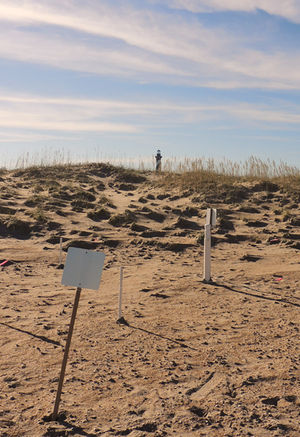
The National Park Service has approved funding for testing in the field beginning in June 2014. Labor is being provided by NerdsWithoutBorder.net volunteers. Additional support has come from:
- IBM -- a grant
- Janus Remote Communications -- a generous discount on their M2M plug-in boards
- Screaming Circuits -- a donation of the labor toward the production of circuit prototypes
- Telit -- publicity
- Frontline Test Equipment, Inc. -- a donation of communications testing equipment
- Bald Head Island Conservancy -- funding for units at a second test location
If the tests are successful, we will seek funding and volunteers to expand the program.
Success in this project would provide widespread, international advantages. As noted above, the stress could be lessened between the protection agencies and the fishing industry, recreational users, and tourism advocates, all of whom desire more beach access. More effective international protection will be available, since the protection resources can be concentrated close to the hatch date instead of being stretched over six weeks. With a tighter hatching schedule, the public would have the opportunity to observe the hatchlings heading for the sea, an observation available only randomly now. This would improve the public support of the turtles. NPS will use the hatch dates in on-site announcements and information centers, and the Hatteras Island Ocean Center will disseminate the information in their programs. Much of the research on sea turtle eggs and hatchlings in the world could benefit from more accurate predictions of the hatch date. For example, studies that require capturing hatchlings for research could be done with much greater efficiency. Also, the sensor/cell network could be adapted for measurements of other species, including birds. Given its modest cost and energy efficiency (long battery life), it may have other uses in environmental studies. All the design information will be available to the public on the wiki http://nerdswithoutborders.net. If the project is successful, this information will be made available at cost or close to cost if sponsors come forward. You can help support the project with a tax deductible donation.
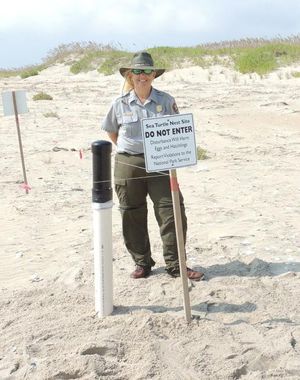
Press
Radio
- Article at PilotOnline.com (Virginia-Pilot) (August 2014)
- Article in Island Free Press(Aug 2014)
- Article in Outer Banks Voice (August 2013)
- Another mention at the Outer Banks Voice
Web
- Article at PsychologyToday.com
- Article at nextgov.com (August 2014)
- Telit press release in the Wall Street Journal (May 2014)
- Blog at iotworld.com
- Blog at hackaday.com
Links
- Hatteras Island Ocean Center website
- Turtle Sense/People -- People involved in this project. If you would like to help with this project, make suggestions, or offer a critique, please email admin@nerdswithoutborders.net.
